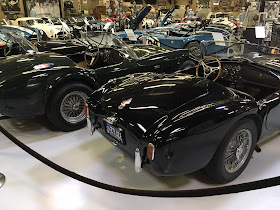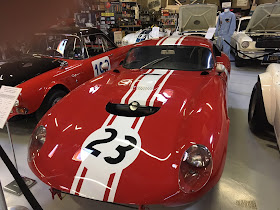Nearly everyone who likes old cars has a Car That Got Away story, and mine involves a Cobra. On my first visit to the Shelby American Collection in the northern reaches of Boulder, Colorado, the guy running the front desk stunned me by remembering a Cobra I'd seen in Denver during the summer of 1973. It was faded metallic red with a busted speedometer, and I'd thought the price was a bit high at $4,700 (back then I only had $2k to my name). He not only recalled this car and the dealer, but actually knew the current owner of the car. He pointed out the Shelby American registry, which tracks the ownership of all known Shelby cars. I decided to return on a recent weekend to do a bit more research, and this time there was another guy at the welcome desk. I've always been curious about the ratio of Cobra replicas to originals, and guessed that of the roughly one thousand Shelby AC Cobras built, there probably couldn't be more than five thousand left. He smiled at this and commented, "Actually, there were 1,007 Cobras built, and we're estimating that there are around 50,000 replicas in circulation." So I'd only been off by a factor of ten...
The history of the Cobras, along with that of the Shelby Mustangs and the mid-engined Ford GT endurance racers, is carefully (some would say obsessively) represented in this museum, with at least one example of every major variation on the design formula for each car. The row of roadsters demonstrating Cobra lineage begins with a 1957 AC Ace Bristol* roadster, the 2 liter six cylinder British car which provided its independently-suspended chassis and sleekly contoured alloy bodywork as the basis for Texan race driver (and idea promoter) Carroll Shelby's first Cobra...
As with many appealingly simple ideas, the Shelby AC Cobra had a complicated gestation. Shelby wasn't the first person to consider a V8 replacement for the tall, heavy Bristol inline 6, which had been based on a pre-war BMW design. The Hurlock family, owners of AC in Thames Ditton, England, had approached the Daimler firm in Coventry about using one of their modern, hemi-head V8s, either the 2.5 liter version in the new Daimler Dart roadster, or the 4.5 liter version which went into the Majestic sedan. Either engine would have been better suited to the AC, which had a more modern chassis than either Daimler and a much sleeker and more coherent body design than the Dart*. When their request for V8 power was turned down by the Daimler people (who soon sold the company to Jaguar), the Hurlocks took dealer-tuner Ken Rudd's advice and offered the English Ford 2.6 liter Zephyr inline 6 in various stages of tune, then modernized the lines of their Ace roadster by standardizing a curved windshield and a simplified grille opening with the famous "mustache" contour smoothed away. Starting in 1961, AC built just over 3 dozen of the Zephyr-powered roadsters and another 8 Aceca coupes, but in 1962 Carroll Shelby took the Ford idea one step further by approaching AC when Ford released a couple of its new Fairlane V8 engines to him. The AC works built a prototype with relocated steering box to clear the new engine. Internally this was known as the "3.6 liter" as it was built with the 221 cubic inch engine, but this was traded for the larger 260 version when the car was delivered to Shelby American's SoCal workshops, and the first 75 of the Series 1 Cobras were outfitted with the 260. Another 51 Series 1 cars would be built with the 289. The prototype was originally fitted with inboard rear disc brakes flanking a differential like that on an E-Type Jaguar, but the brakes were moved outward on production cars. Another change from the prototype was moving the fuel filler from the rear fender to a central position above the trunk opening.
That first Cobra, CSX2000, shown above as it appears at the museum in Boulder, shared the latest windshield and grille opening with the Ford Zephyr-powered cars, plus radiused wheel arch extensions formed into the alloy bodywork which added space for wider tires as well as visual (and perhaps actual) strength to the wheel openings. Tested in England by Shelby and Derrick Hurlock, the V8 provided far more horses than the 170 offered by racer Ken Rudd's maximum tweak of the Ford 6, the version with aluminum head and triple Weber carbs. As Shelby's V8-powered version was more cost-effective than the Ruddspeed 6, production at AC Cars would shift to the V8 program, for both the home and American markets, during 1963. This first Cobra is displayed with a lot of what collectors call "patina" and is in the same condition as received when purchased at auction from the Shelby Trust by the Miller family. That includes seats with a certain lived-in look...

If CSX2000 is the founding icon of the Cobra creation story, CSX2345, displayed two cars down, may be the Holy Grail of Cobra roadster road racers. With no less than six 1st place finishes during 1964 and 1965, it helped the Shelby American Team win the 1965 F.I.A. World Manufacturer's Championship. And while it's one of two survivors of the five F.I.A. roadsters built, it's the only one to remain intact...
In this case, "intact" means the same condition it was in when it completed the 1965 road racing season by winning at the Rossfeld track in Germany. The car's owner told me that he still exercises it at vintage car meets; it won two 1st prizes at the Pebble Beach Concours in 2012. Both awards reflect the growing concern for maintaining historic cars in a condition reflecting the way they were built and used, rather than the sort of over-restored, "better than factory-fresh" approach that ruled car shows in decades past. The dents and scratches on CSX2345 were hard-earned...
One of six Cobra Daytona Coupes sits between the Cobra prototype and the F.I.A. roadster. The aerodynamic coupe body was designed at Shelby American by Pete Brock*, a prolific shaper of slippery road racers. The Daytona body added roughly 20 mph to the Cobra's top speed, and helped win the 1965 Manufacturer's Championship.
In addition to the blue Daytona shown above, the museum displays the red Willment Cobra coupe below. British Ford dealer John Willment had success racing an early Cobra roadster, but was turned down when he attempted to order a Daytona from Shelby. Undaunted, he commissioned his own alloy body on a bare Cobra chassis. There are numerous differences in form and detail between the right-hand drive Willment and the Daytona, but both had successful careers. The Willment car won its first race at Snetterton in 1964...
In its mission to commemorate all aspects of the Shelby American racing efforts, the collection includes the Sunbeam Tiger parked next to the Willment Cobra, and several Shelby Mustangs like the white example you can see in the background behind it. Then of course there are Cobras raced in the SCCA, the USRRC, and a drag racer or two...

And that's a Ford GT40 in the foreground above. The museum has examples of each phase in the progression of the GT40 development, with examples of the the Mk. I, the 7 liter Mk. II, the Mk. III offered briefly as a road car, and the Mk. IV. In the photo below, the GT40 (chassis # GT/104) that finished 3rd at Daytona lurks behind a 427 Cobra, and sits in front of the Falcon panel van which once belonged to Pete Brock and served as a tow car for the team. There's a lot of history captured between the walls of this museum, and we will return to the subject of the Ford GT40 in Part 2...
The Shelby American Collection has a stunningly complete collection of historic race cars and artifacts from the Golden Age of road racing, but its presentation is informative, friendly and unpretentious. In fact, the gentleman dispensing tickets and information last Saturday turned out to be Steve Volk, the Collection's President and the owner of that F.I.A. Cobra roadster as well as the ex-Pete Brock Falcon. Imagine how surprised you'd be to encounter the Curator of Collections at the front desk on your next visit to, say, the National Automobile Museum in Reno. The Shelby American Collection is open to the public on Saturdays only, 10 AM to 4 PM, and admission is $5. The museum is supported primarily by the annual raffle of a car, and this year it's a new Shelby Mustang GT350R. There will be more on that, and those Ford GT40s, in Part 2.
*Footnotes, bibliography & miscellany: The Shelby American Collection's website (shelbyamericancollection.org) is an excellent source of facts and figures on many of the cars it displays. Other stories from this blog's archives related to today's post include a survey of Pete Brock's work entitled Unsung Genius from 1/16/17, Happy Accidents with Bristol Power, from 12/24/16, Forgotten Classics: AC Part 2 from 12/25/16, AC Part 3 from 1/9/17 and AC Part 4 from 8/20/17. There are also notes on the Daimler Dart V8 in Worst Car Designs Ever: Part One, a Tale of Two Darts, from 7/28/16.
Photo Credits: All photos are by the author.








Thank you for this article. I need to add this to my list of must visits.
ReplyDeleteFor detailed histories of each individual car in the Collection (as of 2008), see the book Shelby Cars In Detail. It's out of print now (2023) but still available on Amazon at double its original price!
ReplyDeleteOn one visit to the Shelby Collection, I had an informative talk with Steven Volk, who was a fountain of information on these cars. At the time, he also owned 3 of the cars on display. I'm guessing you probably talked with him when researching your book.
ReplyDelete